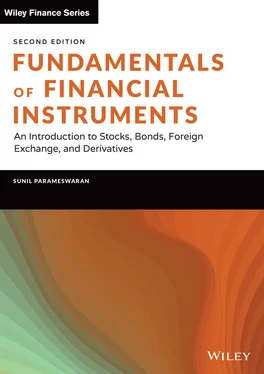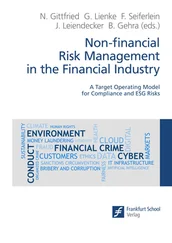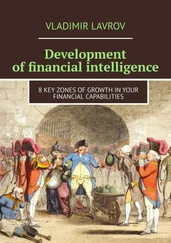I hope that the book serves as a source of pertinent and comprehensive knowledge for readers everywhere.
Sunil K. Parameswaran
Director & CEO
Tarheel Consultancy Services
Manipal, India
November 2021
Preface to the First Edition
This book grew out of my lecture notes used for corporate training programs in India and abroad. The feedback from participants has been invaluable in polishing and refining the exposition. The eventual flow and clarity that I believe I have been able to achieve is in no small measure due to the critical and incisive inputs of my students as well as professional acquaintances.
There is typically no course exclusively on financial instruments in most MBA curricula. Consequently, this topic invariably gets combined with material on financial institutions as part of a course on Financial Markets. I, however, believe that there is a strong case for offering a comprehensive course on financial instruments for second-year MBA students. However, care should be taken to ensure that material which is covered in traditional courses like Financial Derivatives and Fixed Income Securities is not repeated any more than is necessary. Many students who take such a course may not be majoring in Finance and consequently may not take specialized courses such as Derivatives. For them therefore the specter of substantial overlap is less of an issue. Even for students of Finance, despite the inevitable repetition of facets of topics such as Bonds, Futures, and Options, a course on instruments is a comprehensive and integrated offering that will serve them in good stead in the future.
The book starts from first principles and builds in intensity. Exposure to one or more courses on Financial Management will certainly be useful for the reader as he or she navigates through the material. While the book is a standalone treatise on the subject, readers may like to augment it with standard texts on issues in Finance such as Security Analysis, Bond Markets, Futures & Options, and International Finance.
The issues covered in this book are universal and of relevance for students of Finance as well as market professionals irrespective of where they may happen to be located. However, most of the illustrations and examples pertain to markets in the developed world, particularly the United States, and the products that trade in them. Consequently the book should have appeal for readers in all parts of the world.
Readers are welcome to share their comments and suggestions with me. Constructive advice and criticism is welcome and will be incorporated while undertaking revision of the material in future. My E-mail ID is: skp@tarcon.org
I hope that the book serves as a source of pertinent and comprehensive knowledge for readers everywhere.
Sunil K. Parameswaran
T.A. Pai Management Institute
Manipal – 576104
Karnataka, India
I am indebted to all my students in India and Australia who went through this material and offered ideas for embellishing the content and polishing the exposition. The participants at my Executive Education programs offered invaluable advice. Because most of them were non-Finance professionals, primarily from the Information Technology field, they had unusual and interesting perspectives which helped augment the more traditional feedback from business school students and associates.
I am extremely grateful to John Wiley & Sons, Singapore, for giving me the opportunity to develop and promote this book. In particular I owe a tremendous debt to my former publisher, Nick Wallwork, for taking a chance with an unknown Indian academic. Gladys Ganaden, who subsequently took over, has been an enormous source of support and encouragement. She is the primary force behind the second edition of the book, for she perceived the need and inspired me to write it. I am indebted to her.
The editorial team of Purvi and Pradesh has been very supportive of this project right from the outset and I owe them an enormous debt. Donna, who was the copyeditor, has done a wonderful job, and has provided invaluable support at the copyediting and typesetting phases.
And finally, I am indebted to my mother for her patience and moral support.
Sunil K. Parameswaranis the director and CEO of Tarheel Consultancy Services, a corporate training and management consultancy firm set up by him in 2004.
Sunil is a Visiting Faculty at some of the leading business schools in India, where he anchors courses in the area of Finance. His primary areas of interest are Securities Markets; Financial Derivatives; Fixed Income Securities; and International Finance.
For the past 20 years Sunil has been active as a corporate trainer and management consultant. He has delivered training programs on Global Securities Markets and Global Banking to some of the multinational IT firms located in India. Sunil also has over 30 years of teaching experience and has taught at leading business schools in the United States (University of Iowa), Singapore (National University of Singapore), Australia (La Trobe University), and India.
His past clients include WIPRO Technologies, HCL, Capgemini, Accenture, Microland, and JPMC.
Sunil obtained his PhD in Finance from the Fuqua School of Business at Duke University in North Carolina. He obtained his MBA from the Indian Institute of Management, Bangalore, and holds an undergraduate degree in Chemistry from St. Stephen's College, New Delhi.
A prolific writer, he has published several books with John Wiley & Sons in Singapore and DeG Press in the United States. His most recent book is Fixed Income Securities , published by DeG Press, Boston/Berlin.
CHAPTER 1 An Introduction to Financial Institutions, Instruments, and Markets
THE ROLE OF AN ECONOMIC SYSTEM
Economic systems are designed to collect savings in an economy and allocate the available resources efficiently to those who either seek funds for current consumption in excess of what their resources would permit, or else for investments in productive assets.
The key role of an economic system is to ensure efficient allocation . Efficient and free flow of resources from one economic entity to another is a sine qua non for a modern economy. This is because the larger the flow of resources and the more efficient their allocation, the greater is the chance that the requirements of all economic agents can be satisfied, and consequently the greater are the odds that the economy's output will be maximized.
The functioning of an economic system entails making decisions about both the production of goods and services and their subsequent distribution. The success of an economy is gauged by the extent of wealth creation. A successful economy consequently is one that makes and implements judicious economic decisions from the standpoints of production and distribution. In an efficient economy, resources will be allocated to those economic agents who are able to derive the optimum value of output by employing the resources allocated to them.
Why are we giving so much importance to the efficiency of an economic system? The emphasis on efficiency is because every economy is characterized by a relative scarcity of resources as compared to the demand for them. In principle, the demand for resources by economic agents can be virtually unlimited, but in practice, economies are characterized by a finite stock of resources. Efficient allocation requires an extraordinary amount of information as to what people need, how best goods and services can be produced to cater to these needs, and how best the produced output can be distributed.
Economic systems may be classified as command economies or as free market economies. This definition refers to the two extreme ends of the economic spectrum. In practice, most modern economies tend to display characteristics of both kinds of systems, and they differ only with respect to the level of government control.
Читать дальше












